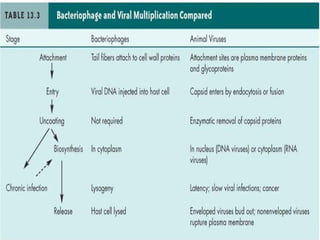A brief introduction of viruses
- 1. A BRIEF INTRODUCTION OF VIRUSES Concluded By- Name- Musharraf Ali Course- M.Tech (BCE) IIT BHU R.N.- 15012006
- 2. INTRODUCTION ŌĆó Viruses are obligate intracellular parasites of bacteria, protozoa, fungi, algae, plants, and animals. ŌĆó In the 1890, D. Ivanovski and M. Beijerinck showed that a disease in tobacco was caused by a virus (tobacco mosaic virus). ŌĆó Friedrich Loeffl er and Paul Frosch discovered an animal virus that causes foot-and-mouth disease in cattle. ŌĆó The concept of a filterable virus introduced at that time.
- 3. ŌĆó The exceptional and curious nature of viruses prompts numerous questions, including- 1. How did viruses originate? 2. Are they organisms; that is, are they alive? 3. What are their distinctive biological characteristics? 4. How can particles so small, simple, and seemingly insignificant be capable of causing disease and death? 5. What is the connection between viruses and cancer?
- 4. Properties of Viruses ŌĆó Obligate intracellular parasites of bacteria, protozoa, fungi, algae, plants, and animals. ŌĆó Ultramicroscopic size, ranging from 20 nm up to 450 nm (diameter). ŌĆó Not cellular in nature; structure is very compact and economical. ŌĆó Inactive macromolecules outside the host cell and active only inside host cells. ŌĆó Basic structure consists of protein shell (capsid) surrounding nucleic acid core. ŌĆó Nucleic acid can be either DNA or RNA but not both. ŌĆó Nucleic acid can be double-stranded DNA, single-stranded DNA, single-stranded RNA, or double stranded RNA. ŌĆó Molecules on virus surface impart high specificity for attachment to host cell. ŌĆó Multiply by taking control of host cellŌĆÖs genetic material and regulating the synthesis and assembly of new viruses. ŌĆó Lack enzymes for most metabolic processes. ŌĆó Lack machinery for synthesizing proteins.
- 5. The General Structure of Viruses ŌĆó Size Range- Most of them are so minute(0.2╬╝m) therefore an electron microscope is necessary to detect them or to examine their fine structure. More than 2,000 bacterial viruses could fit into an average bacterial cell, and more than 50 million polioviruses could be accommodated by an average human cell. Animal viruses range in size from the small parvoviruses 1 (around 20 nm in diameter) to poxviruses 2 that are as large as small bacteria (up to 450 nm in length).
- 8. Modes of Viral Multiplication
- 12. Techniques in Cultivating and Identifying Animal Viruses >Primary purposes of viral cultivation -To isolate and identify viruses in clinical specimens -To prepare viruses for vaccines -To do detailed research on viral structure, multiplication cycles, genetics, and effects on host cells
- 13. 1- Using Live Animal Inoculation - Specially bred strains of white mice, rats, hamsters, guinea pigs, and rabbits - Occasionally invertebrates or nonhuman primates are used - Animal is exposed to the virus by injection 2- Using Bird Embryos - Enclosed in an egg- nearly perfect conditions for viral propagation - Chicken, duck, and turkey are most common - Egg is injected through the shell using sterile techniques
- 14. 3- Using Cell (Tissue) Culture Techniques ŌĆó Most viruses are propagated in some sort of cell culture ŌĆó The cultures must be developed and maintained ŌĆó Animal cell cultures are grown in sterile chambers with special media ŌĆó Cultured cells grow in the form of a monolayer ŌĆó Primary or continuous.
















